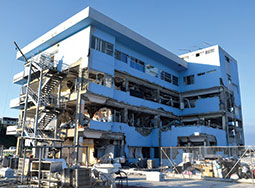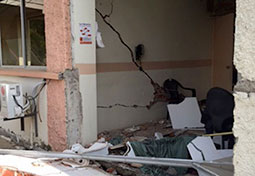
O
n 16 April 2016, one of Ecuador’s worst disasters—a magnitude 7.8 earthquake—left 663 dead and nine missing. As of mid-May, 7,633 families, or 28,775 people, remained in shelters. The earthquake also affected many potable water systems. In the first 72 hours, 6,274 persons received medical attention. The earthquake affected six provinces along Ecuador’s Pacific coast: Esmeraldas, Manabí, Santa Elena, Guayas, Santo Domingo de los Tsáchilas and Los Ríos. However, the provinces of Manabí and the south of Esmeraldas were the most affected.
The region’s health infrastructure also was dealt a serious blow, particularly in 12 cantons in Manabí and Esmeraldas. Thirty-nine health facilities, which include health centers and basic and general hospitals and those providing specialized services, were damaged and 20 were unable to continue functioning. Despite the damage to the health infrastructure, medical care continued to be provided in mobile units, tents, or through services that were relocated to other facilities.
| Level 1* EMTs | Level 2** EMTs | Specialized Cells | |||
| National | International | National | International | National | International |
| 20 | 1 | 3 | 2 | 6 | 2 |
* Level 1: Outpatient initial emergency care of injuries and other significant health care needs.
** Level 2: Inpatient acute care, general and obstetric surgery for trauma and other major conditions.
| In the most affected areas (the cantons of 24 de Mayo, Bolívar, Chone, Flavio Alfaro, Jama, Manta, Paján, Portoviejo, Puerto López, Rocafuerte, Sucre, Esmeraldas and Guayaquil’s metropolitan district ) the situation in health facilities is as follows: | |
| Hospitals | |
|
Damaged: 15 |
Unable to function: 6 |
| Health Centers | |
|
Damaged: 24 |
Unable to function: 14 |
| Twelve of the 15 hospitals in cantons located in the province of Manabí were damaged. | |
|
IESS Hospital in Manta. | |
|
Interior of the Bahia de Caraquez hospital in the province of Manabí, Ecuador. | |
The Ministry of Public Health used the international standards for minimum requirements and classification of Emergency Medical Teams, promoted by WHO/PAHO (read the guidelines at http://bit.ly/1SNgc5V) for the coordination and deployment of national and international emergency medical teams. To execute this operation, an Emergency Medical Teams Information Cell (CICOM) was set up in Quito’s ECU 911 Emergency Center, under the responsibility of the International Cooperation Department of the Ministry of Health. The CICOM helped to organize the deployment of EMTs to the disaster-affected areas of the country, optimize the work of health responders, and improve the quality of information regarding health coverage. Ecuador is the first country in the Americas to put this coordination mechanism to the test.
The Ministry of Health set up two staging areas in Quito and Manta to register and control the movement of medicines and medical supplies into and out of the warehouses, using the LSS/SUMA system. Rapid Response Teams were activated, a health situation room was set up, and an epidemiological surveillance system was put in place in shelters and temporary camps. Integrated Healthcare and Primary Healthcare teams were also deployed to the most affected areas. Potable water was distributed in shelters using tanker trucks, mobile water treatment plants and bottled water.
The Ministry of Public Health, the Red Cross, universities, and national and international NGOs immediately addressed mental healthcare needs. Action was taken to control, prevent and address violence and behavioral disorders, and counseling was provided for disaster victims who lost family members and property. A psychosocial support strategy, oriented toward ‘caring for the caregivers,’ was developed.
The Pan American Health Organization’s regional headquarters and the country office for Ecuador also mobilized staff to support the Ministry of Health’s earthquake response, especially in humanitarian coordination, damage assessment (particularly with regard to health infrastructure) and needs analysis, coordination of emergency medical teams, and logistical supply management. PAHO/WHO also continues to work closely with national authorities on epidemiological surveillance, restoration of health services, immunizations, mental health, and communication and information management.


